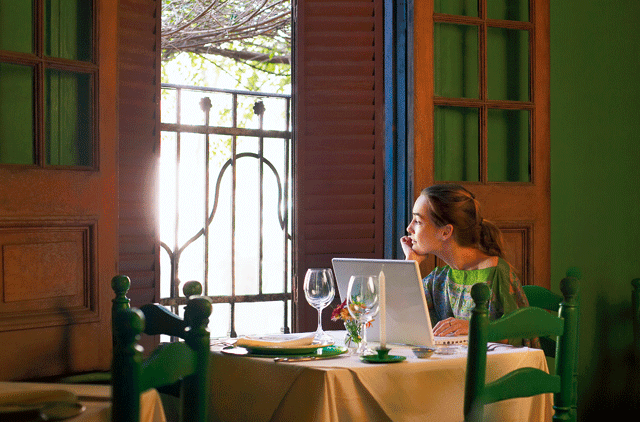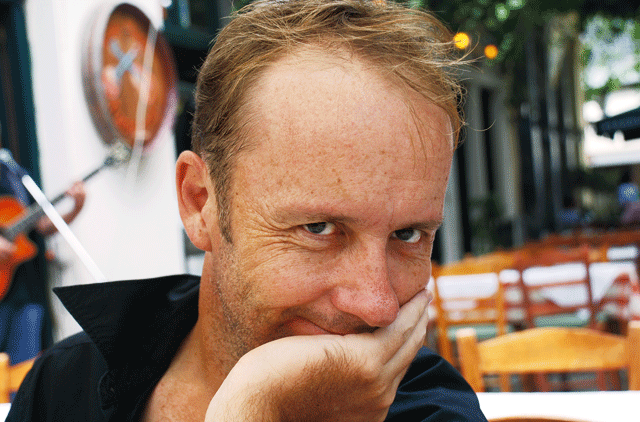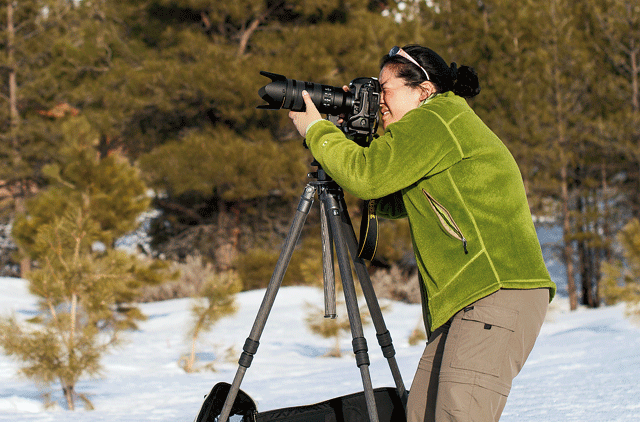
It starts with a name that makes you go mm-mm: A Slice Of Cherry Pie, Cream Puffs In Venice, Tea And Cookies, Use Real Butter or Not Without Salt. These are web addresses of food blogs.
Or online journals that serve unrestrained culinary titbits, secret recipes, crazy cooking methods, food-related musings, ravishing visuals, and best - original content. All served with honesty and humour, thus generating, rather easily, gustatory pleasures from a mere mouse click.
Some blogs have great ideas. Like the blog with hand-drawn recipes by London-based duo Amelie Labarthe and Tom Ballhatchet who think we ought to cook from pictures, not text.
Some have unusual content. There is blogger Helen Yee who posts from Sydney on her passion for eating silkworm pupae and Nicole Stich from Munich who talks about unexpected ingredients. (Yee's blog is called Grab Your Fork and Stich's Delicious Days.)
According to Technorati, an internet search engine that tracks blogs, there are more than 33,000 food blogs. Each a hearty broth of recipes, food photography, restaurant reviews, personal stories, and observations on local and international food culture. A few even throw in their support for larger movements like organic farming and slow cooking.
Blogs have rankings too. Labarthe and Ballhatchet's blog (RecipeLook.co.uk) for instance gets more than 2,000 hits a day. Clearly, the fast-growing community of food bloggers is satiating our voracious appetite for all things related to food.
But who are these bloggers?
They are passionate about food for sure. Good writers too. Technically savvy as well. And evidently, they have a knack for maintaining connections with a large online community. Still, who are they? Are they connoisseurs of food or paladins of food history? Are they travelling bons vivants? Why do they blog? Three bloggers share their thoughts.
Matt Armendariz posting from Los Angeles, California
The hotel brought in a pizza maker from Naples who's made pizza for 40 years. He created perfect pizzas in the outdoor oven one at a time, each one of us taking piping hot pizzas consisting of nothing more than wood fired dough, tomatoes, mozzarella and basil. Even the oven used olive and lemon branches for fire. I will forever understand what the best pizza in the world is all about.
Armendariz finds himself in amazing situations that he "just can't help sharing". He says, "Blogging is just like my photography or design in that I need to express myself."
He has been involved in food marketing and advertising for 20 years as a graphic designer, art director and creative director. He says, "When you are paid to promote someone else's message or product there isn't much room for personal input. However, I was meeting amazing people in the food world - cheese makers, farmers, growers, etc, and wanted a place to share their story, and my personal take on what they did."
That personal space he refers to is recognised as one of the top food blogs by The Times, UK. He has been blogging since 2005, focusing on his personal experiences with food and travel. He reviews cookbooks and offers behind-the-scenes glimpses of being a food photographer. He is one of the few food bloggers with a background in food, graphic design and photography.
"Because of my history I'm able to swirl those things together in a way that defines what I do," he says.
While his background explains his ease in visual direction, he admits he has help with the technical and editing aspect. He says one needs several attributes to maintain a food blog. "Passion; drive; a deep appreciation of food; and the ability to remain positive. The beauty of food blogging is that everyone eats. Everyone has a unique perspective on what they do. It's democratised publishing for so many - I dig that."
Still maintaining a blog is only a part of the challenge. The task is also to engage the online community. Armendariz knows most of his readers: his close blogging friends. "Food lovers are generous people… we thrive when we are together, sharing meals," he says.
He treats blogging as any work-related commitment. "I treat it as I do most other things I work on… Posts involve weeks and sometimes months of research like travelling; and when I interview celebrities, it takes some work before I begin."
Blogging can be a full-time endeavour, more so because he creates editorial and visual content. "But that doesn't mean I necessarily earn a full-time living off my blog. People should know that we [bloggers] spend quite a bit of time blogging; it's a labour of love," he says.
When not taking photos, Armendariz regularly speaks on food and styling at workshops, seminars and blog conferences. Recently he was a speaker at the International Association of Culinary Professionals (IACP) in the US. He is also a contributor to Food Network's Cooking Channel, writing a monthly column about cooking.
Mark Lowerson, posting from Hanoi in Vietnam
Twenty years ago, when Vietnam was still somewhat in the doldrums, this snail vendor started passing by Hanoi's Truc Bach village, just north of the Old Quarter. Each afternoon, she sets up her two-basket operation in a tiny alley where the only through-traffic is to one or two homes that lie at its end. She hangs a nondescript sign, signalling that all is in readiness.
Lowerson's love for food goes back to his roots. "I grew up in a household with passionate foodies, five out of six [of us] have a bit of flair in the kitchen. Before I came to Vietnam, I ran a cafe in Fitzroy in Melbourne's inner suburbs for four years with one of my sisters. Also, I am interested in language being an English and English Literature teacher. So it was just a matter of putting two interests together with technology at the time."
The time he speaks of is in 2005 when he started a blog with his friend Kate Henry. At the outset, they were certain of one aspect: they did not want it to be a traditional food blog, posting recipes from the kitchen.
He says, "I can't remember how we determined the name, but we wanted it to reflect where we were [Vietnam] and the theme of the blog [food]. For it to be successful, we would have to post regularly and develop a style/voice that was in some way unique. We also wanted it to reflect Hanoi, Vietnam, Asia and some of what it entails to live here as expatriates."
They named it stickyrice, referring to it as a quirky and distinct small voice that comments on street food, markets and makes little food-related observations.
Far from a full-time endeavour, Lowerson would blog late at night. It was his creative outlet where he could play with words, cameras and eat a lot of "incredibly cheap food".
After Henry left in 2006, the maintenance of the blog devolved upon him. Since then, he has continued to focus on street food and food culture in Vietnam, spending up to 10 hours a week on the blog, not including "the eating".
His blog has observational material as well. He says, "People enjoy my blog primarily for the writing because it's not all that informative in the traditional sense. I take all the photographs, edit and manage them in flickr [image hosting website]. The technical side can be challenging, but only if I want to change the appearance or add something to the sidebars, which I don't do often. No one edits, and the readers are my only critiques. I recently started tweeting, and have gotten better at garnering extra readership [for stickyrice]. It [Twitter] is a fun application that makes me feel connected to other similarly minded people."
Though Lowerson likes the interaction with readers, he says with the advent of Facebook and Twitter, the number of comments appears to be on the decline. "It is not a commercial exercise and I don't have ads [on the blog]. Blogging is a part-time passion."
Neither does he keep track of the hits. "When I've checked in the past, most of the traffic comes from the United States. This year, I've noticed a lot more comments from local Vietnamese people."
Jennifer Yu posting from the Rocky Mountains of Colorado
As my regular readers know, I am undergoing my chemo treatment now. My oncologist is a very sweet man who reminds me of Captain Kangaroo. He poisons me every three weeks - he even got me on Valentine's Day. But he tells me that I'm going to be OK. I would like to believe him.
And then the freelance food and nature photographer wrote, "It took me all day to make these petits fours. While I folded the batter for the chiffon cake, I thought…"
Like many bloggers, Yu didn't set out to write a food-specific one. She started a typical blog on daily minutiae and personal observations, reserving a fraction to food. It was only after she heard of an online baking group called The Daring Bakers that she divided her blog into personal and food. Yu named her food blog Use Real Butter. She came up with the name on a whim. "People around me always used margarine to bake; and it would creep me out," she says.
Her blog has her favourite recipes and musings on what she finds interesting and worth sharing. "The main deviations pertain to my nature photography, travel, social gatherings, and my black dog," she says.
Yu, who is a former NASA engineer, holds a PhD in geology from Cornell University and BS degree in engineering from the California Institute of Technology, has been blogging since November 2004, averaging about 20 hours per week.
"I'm all about efficiency," she says.
So Yu cooks and photographs several recipes at once, working with other deadlines, clients and making time to travel. "I provide my own visual content. I manage about 25 per cent of the technical aspects, but my husband is my very dependable and brilliant system administrator and my casual editor despite his duties as a professor of astrophysics," she says.
Yu plans to stop blogging when it ceases to be fun. "But it is still fun. It has also grown into a social activity that is both fun and gratifying."
Through her readership base, comprising mostly women between the ages of 18 and 65, Yu made friends. When she was diagnosed with cancer, her blog became a conduit, connecting her to a world she couldn't physically reach out to. She says, "I didn't know what would happen to the blog, to my life, to me… Chemotherapy was an isolating experience because, in part, we live in the sticks, and I couldn't risk exposure to germs [public places]. Blogging from home allowed me to maintain the interaction, something I looked forward to each day."
For Yu, her readership base is sacrosanct and valuable. "It's not a business for me. I understand that a readership commands value in the eyes of marketers, but I avoid products I don't like. I try to promote local [Boulder, Colorado] businesses that I frequent; they don't ask me to write about them, I do so of my own accord."
She also despises the popularity rat race. "I like the idea of doing something I love, doing it well, putting it out there, and not caring about the rest," she says. "That's how I blog. That's how I live."
What does it take?
To be a food blogger, it isn't enough to be passionate about food. What are the prerequisites?
Jennifer Yu has a "huge bone of contention" with panels and posts on ‘How to be a food blogger'. She says, "These guidelines are ultimately creating a cookie-cutter community of blogs that all aspire to look, sound, and feel the same with the ultimate goal of popularity. I have no use for that. The blogs that stand out are ones that offer something original and interesting. This depends on the individual behind the blog. If blogging is about money, traffic, popularity or business, I don't want it."
Echoing Yu's principle is Matt Armendariz. He too doesn't believe that there is a formula for a successful blog. "If you look at popular food blogs and [food] bloggers, you will notice that they are unique. If you begin blogging with the sole desire of gaining popularity and recognition, you will eventually fall flat on your face. One should be most concerned with creating original, engaging content," he says.
For Mark Lowerson though, a successful blog hinges on personal gratification. "If a blogger can communicate some kind of passion in a way that connects with people while simultaneously continuing to feed their own creative desires, that's enough."
Extra helpings
When Jennifer Yu isn't cooking, photographing or entertaining, she is hiking, mountain biking, mountaineering or telemark skiing.
Armendariz's advertising clients include Chiquita Banana, Fiji Water, Time Magazine, Culture Magazine, and a variety of national and local accounts in the US. His editorial work has been featured by Martha Stewart, Bon Appetit and Culture Magazine.
Lowerson says, "Western constructs like slow-cooking may very well exist in Vietnam anyway, but they don't necessarily hold currency in Asian cultures."














